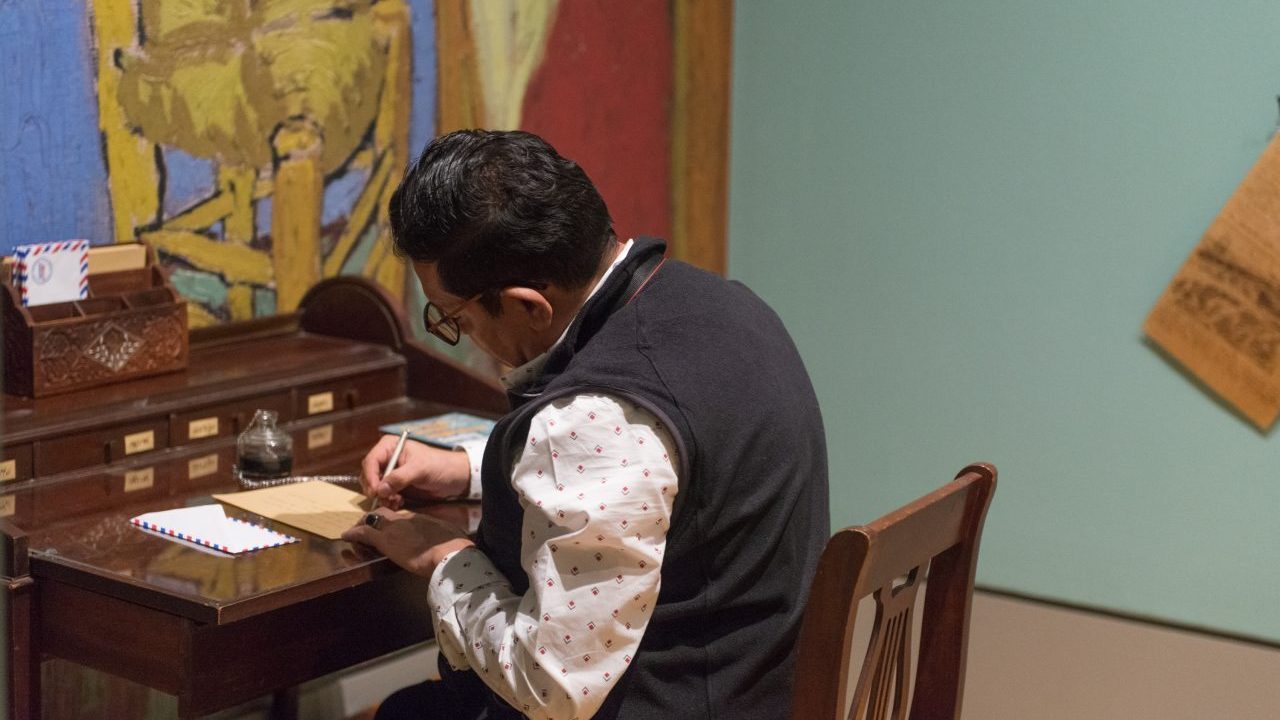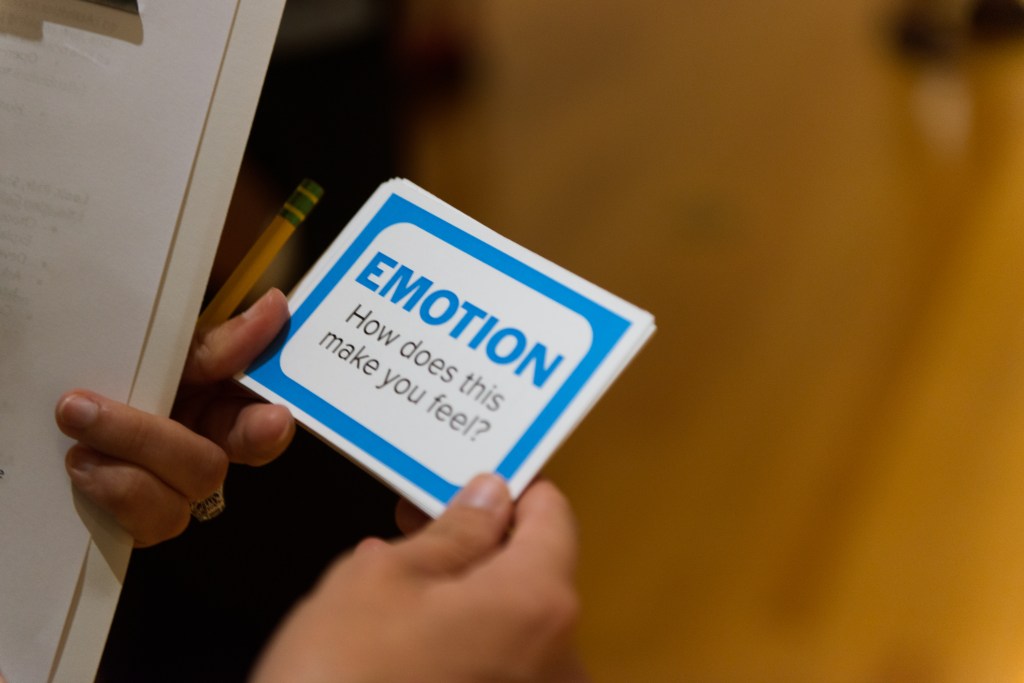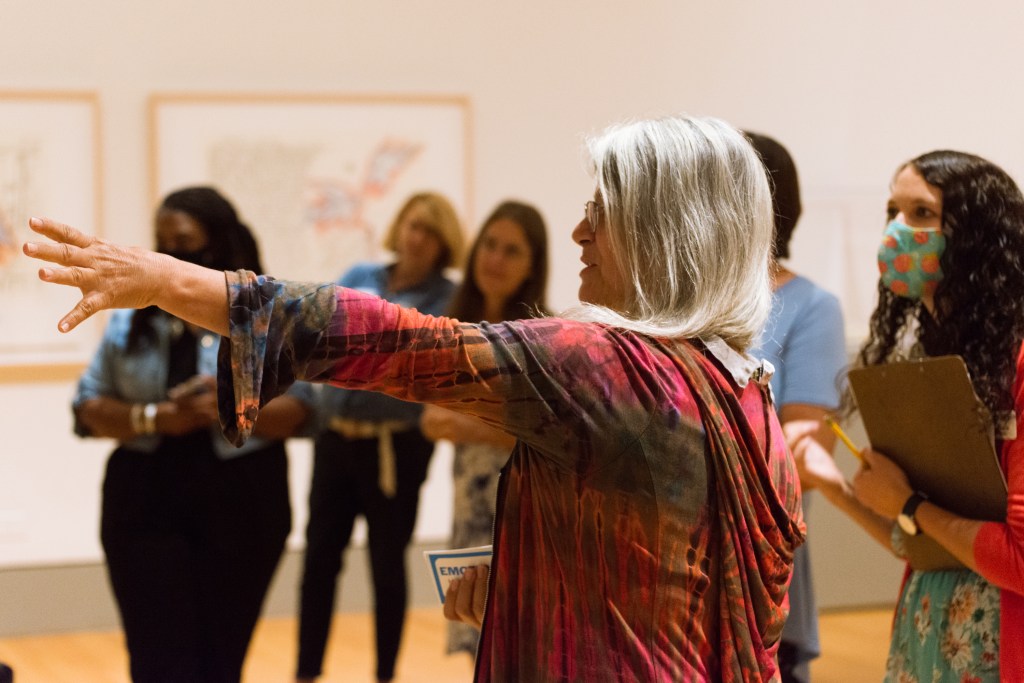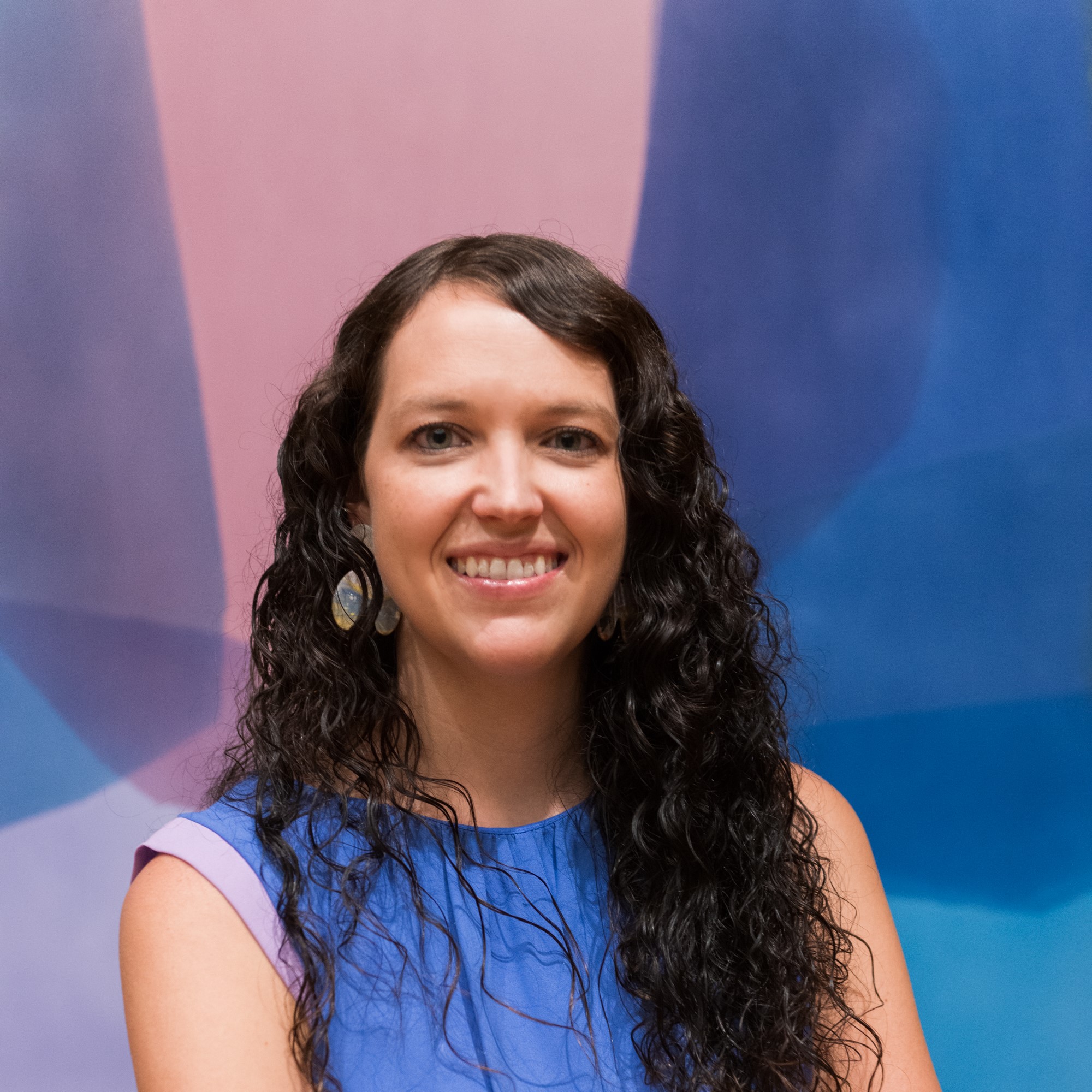
A picture is worth a thousand words. Or so the aphorism tells us. What, then, is the value of a single word?
That is the question I have explored time and again as an educator in an art museum. It might seem counterintuitive that someone at an institution which deals primarily with imagery would be preoccupied with words. But the longer I’ve been in the role, the more I have come to see the importance of language. How does one capture the idea of something as intangible as a work of art into something as discrete, and yet paradoxically expansive, as a single word?
This question became even weightier as I began to write verbal descriptions of pieces in preparation for tours designed for visitors who are blind or have low vision. Relying on only words to describe an object stretches the limits of one’s language. One must consider not only the object’s physical attributes (subject, size, texture) but also the overall feeling it suggests. The prospect of color offers up its own special challenge. How does one describe a deep gray to someone who might not have a mental image of the color? The feeling of a pensive sky, heavy with clouds about to storm? Or is it the coldness of a pewter vessel, metallic and solid? This exercise crystallized the importance of language as a tool to engage, to challenge, and to express the ineffable. It spurred me to think about all the different ways words help us to make sense of the visual—and how, and why, we can and should infuse them into informal learning spaces.
At the museum where I work, the Columbia Museum of Art (CMA) in South Carolina, we’ve adopted a framework that helps to guide our thinking and forms the basis of our educational philosophy. Always the ardent admirer of alliteration, I termed these the Three C’s: contemplate, connect, and create. They have since become the way I frame my thinking about everything from interactive elements to pedagogy and, in this case, language. Here’s how I’ve used this framework to experiment with language interventions to make the museum more engaging to visitors.
Contemplate: Look Longer, Think Deeper
By design, museums invite reflection and allow for space to sit, think, or just be. But that doesn’t mean this practice always comes easily. Slowing down and looking deeply can be at odds with our increasingly harried mentality, as we struggle to process the glut of visual information that bombards us every day. In 2015, Time magazine published an article that proclaimed the average human attention span had dropped to eight seconds, even lower than the oft-maligned goldfish, which clocks in at nine seconds. This is potentially troubling for a variety of reasons, but in the context of a museum, where the goal is to encourage looking at, learning about, and connecting with objects, it presents a particular challenge.
One way to spur more thoughtful consideration is by inviting visitors to approach works of art in new ways. Simply offering up an interactive element that attracts their attention and sparks their curiosity can lead them to linger longer and look more closely. This can be especially helpful for people who feel out of place in museums, as if they must come in with some prior knowledge to look at a piece and “get it.” It signals that there is no one right way to engage with what’s on display, giving the visitor the agency to direct their own experience.
We experimented with this strategy in a recent exhibition the CMA hosted, 30 Americans. The exhibition included artwork that dealt with some difficult issues, including slavery, racism, colorism, and homophobia, and, particularly after facilitating some pre-exhibition community conversations, we wanted to provide an outlet for people to process the emotions that might arise. Our solution was to create sets of cards printed with the names of different emotions, from “anxious” and “upset” to “joyful” and “energized.” The front of the cards instructed viewers to find a piece that conveyed the emotion or made them feel that way. The backs included leading but open-ended questions that invited them to look more closely and try to understand what about the piece was contributing to that feeling.
By making space for people to identify and evaluate their feelings about an artwork, we hoped to underscore that everyone will have a different reaction to something as subjective as a work of art. We have since expanded this activity into our collection galleries so that visitors who drop in at any time can use these words as a springboard to think and talk more deeply about the way a work of art affects them.
Explicitly selecting emotion words was a deliberate choice. For one thing, these are words that are intrinsically abstract, which allows the viewer to connect them to any number of visual stimuli. But beyond that practical consideration, the ability to identify and speak about our own emotions is a skill that very few of us, children or adults, are practiced at. Most of us spend very little time actually thinking about our own emotions.

The process of being able to reflect on these feelings—and, crucially, to label them—is vital to being able to effectively regulate our emotions and how we process them. Being offered a variety of words to choose from provides a launch pad, suggesting words that go beyond the sentiment of simply liking or disliking, while also inviting participants to think of additional sentiments that the artwork brings to mind.
We have also created similar opportunities for our youngest visitors. For instance, several years ago when the museum hosted an exhibition of costumes from films, we provided a set of smaller wearable versions of the costumes in the museum’s education gallery. As children tried on the various outfits, we asked them to reflect on how wearing them made them feel, thereby connecting them to their own emotions and also underscoring the link between costumes and characters. We intentionally chose the words we provided—independent, courageous, mysterious—to spark discussions between children and their adults, to deepen their connection to the experience and to each other.
We also introduce these ideas to younger audiences, albeit indirectly, by working with local teachers. In our workshops on social-emotional learning, teachers spend time in the galleries with emotion cards, reflecting and speaking about the various ways a work of art can express ideas like fulfillment, exhilaration, shock, or unease.

We have used Marc Brackett’s Mood Meter chart, which includes one hundred adjectives, as a resource to identify a broad spectrum of words that are as specific as possible. This practice of building mindfulness and social emotional intelligence has been linked to myriad benefits for both students and teachers, including better academic performance, greater social and leadership skills, and less stress and burnout.
Connect: With Art and Each Other
Words are paradoxically both specific and complex. A word like “culture” has countless definitions and associations, whereas a word like “banana” also encompasses a broad array of varieties but is a concept that is relatively easy to grasp.
With our youngest audiences, we use words primarily to introduce and reinforce the connection between a discrete object (or an image of an object) and its name. We put this concept into practice directly during our monthly preschool program, which is designed for children aged two to five and their caregivers, and centers around discussions of art and objects. The program consists of a structured discussion of art and a story centering on a particular theme, followed by time in the galleries for children and their adults to explore on their own, and culminating in an art-making activity in our studios. At each step of the process, we are continually making clear links between images of particular objects or ideas and the words we use to label or describe them, often incorporating tactile elements or movement to engage with various learning styles.
At these young ages, children are concrete learners, which means that they benefit from seeing and, when possible, manipulating physical objects. Exploring objects is directly linked to language acquisition, so the wider the variety of objects young children are exposed to, the broader array of words they will encounter. Some of these connections are relatively straightforward—for instance, recognizing a Chinese porcelain object as a bowl by relating it to bowls they have observed and manipulated before. But with the rich array of objects we introduce them to, some of which are not everyday items, the conversations can become more complex.
As children grow up, they naturally become better able to express ideas about themselves and the world around them, both physical and emotional. As educators, our role is to foster that language development and give them the tools to be able to express increasingly nuanced ideas. Because art is intrinsically complex and open-ended, even a single image can provide the starting point for an in-depth discussion.
For example, when leading tours of students through our galleries, I often ask, “What adjective would you use to describe this piece?” This not only forces them to return to the image and look closely at it, but requires them to look past more obvious and straightforward descriptors like “landscape” or “person” as they think of an adjective. To warm up to this, we sometimes begin with nouns as an entry point, which allows them to begin with noticing more concrete elements. Then we repeat the exercise with adjectives, asking students to dig a little deeper to come up with more descriptive, and perhaps intangible, words.
This technique is just one of the ways we encourage students to break out of what I call the “Good/Bad/Happy/Sad” box. So often when we ask younger viewers to describe the sentiment or mood of a person or image, their response falls into one of these dichotomies. While being able to identify these distinctions is important for our preschool audiences, we want to urge older students to move beyond this simplistic either-or. By encouraging students to collectively compile lists of words that all describe the same image, we emphasize the fact that there are so many more ways to express complex ideas than if we just scratch the surface, and that everyone brings their own unique and valid perspective to ultimately create a more complete and thorough understanding within the group.
Create: Make It Your Own
Close looking and discussions around works of art are both crucial elements of what we strive to encourage as museum educators. Where we can, we also want to encourage visitors to engage even further by creating something original of their own. We also put this into practice in our teacher workshops, using the opportunity to look at art as a jumping-off point for activities. These often begin with just a single word.
For instance, we may ask participants to match an emotion word to one of the portraits in a particular gallery, using visual clues to justify their connection to that particular feeling. From there, we’ll ask them to write a six-word memoir, inventing a history or state of mind that would account for the way the figure is presented in the image. Once they’ve imagined a backstory, we ask them to pair up and come up with a scenario in which their chosen people would have met and what that encounter might have been like. This exercise helps to further flesh out their imagined personas. To extend the exercise, we can use adjective or emotion cards in our Place gallery, asking participants to find scenes they regard as desolate, hopeful, or serene.

From here, we can combine the two elements, asking them to consider how the figure they described earlier would react in a landscape like the one they’ve identified. At this point, they’ve developed a character and established a setting; with these tools they can go on to frame out a short story or develop the basis of a poem. Breaking these elements down into smaller steps makes the process of writing much less intimidating than an open-ended call to write a poem, which many students and adults would find daunting.
While we have the benefit of facilitating sustained activities with teachers during these workshops, we incorporate similar practices in small ways for everyday museumgoers as well. During a recent exhibition around Van Gogh in our interactive space, for instance, we invited visitors to create their own sketches in the same vein as Van Gogh’s landscapes. Rather than leaving the prompt too broad, we provided adjectives (like “overgrown,” “lush,” and “bleak”) and place names (“meadow,” “thicket,” “riverbank”) for people to choose from. This not only provided a spark to get creative juices flowing, but forced the person sketching to consider the implications of words like “wilderness” or how best to interpret an idea like “turbulent” visually. It also allowed for some levity. We stumbled upon a drawing that had been left behind paired with the words “overcast” and “ranch”—which resulted in a sketch of a bottle of Hidden Valley enshrouded by clouds. A welcome reminder that museums should be places for lightness and humor as much as any other sentiment.
The Why with Words
Whether through formal tours and workshops or through everyday engagement, we at the CMA have found ways to infuse language into the experience for visitors of every age. While the results of these practices may not be easily measurable, we feel the importance of including and diversifying language exposure is demonstrably clear. As an institution we strive to be both educational and engaging, and we have found that words, both big and small, have provided us with countless entry points to do so. Our hope is that our passion for language will, in some small way, spur others to contemplate deeply, connect with one another, and create inspired original works. A picture may be worth a thousand words, but I would contend that a word can connect us to a thousand pictures.









Excellent fusion of art and language, which – even if we don’t want it to – is required of us as viewers and communicators ourselves. I’d like to see a whole panoply of adjectives and other descriptors avaialable to the students to expand the scope and range of language to select from a more diverse – and less predictable – word choices. I would hope that vocabulary as well as a more in-depth assessment skills regarding visual responses would result.
Great idea of keeping the viewer regarding the image, rather than just allowing them to give a cursory analysis.